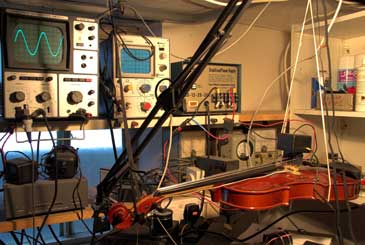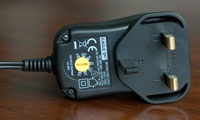
Buy here . . .
Acoustic Enhancer Mk4
for Violin (Viola), Cello and Double Bass
One of two vibrators with adapters fits all.
See it on YouTube HERE
More efficient, quieter, lighter, cheaper.
See how to use it HERE
'Product of the Month Mk2a' in The Strad April 2010
and featured in 'Accessories 2013'
(The Strad October 2013)
Mk2a reviewed in the Strings Magazine
by Greg Olwell (senior editor): see it HERE
Read the test results of Mk2a and comparison with
the ToneRight® HERE
You know how you can pick up your violin and it feels lifeless and sluggish? It’s often caused by lack of use, and playing will usually restore its responsiveness and warmth.
If you regularly play your violins the Acoustic Enhancer may not be of much interest, but otherwise it will help – especially with instruments young in the wood, of trade quality, or which have lain unused for a while. It does not age or mature the wood, but it does improve the acoustic response. I have noticed a marked increase in the harmonic content of the open strings. They are much more readily excited sympathetically by stopped notes.
Just as the human body or a car engine benefits from exercise, so does a stringed instrument.
The theory behind the Acoustic Enhancer for Violin is gentle vibration through the bridge for 72 hours or more, simulating the playing-in needed by a new or rested instrument.
Background
I first read about this vibration theory in A Treatise on the Structure and Preservation of the Violin by Jacob Augustus Otto 1848 (published by William Reeves, London) where he writes about having bought a well-used but very ordinary violin …
which, although every judge knew it to be a trade instrument, was not inferior in tone to an Italian one … This led me to imagine that constant vibration shakes the resinous particles out of the wood, whereby rendering it more porous and better adapted for producing a good tone, than it otherwise is.
The author refers back to the procedure detailed in his 1828 edition of the same book in which true perfect fifths are bowed for 15 minutes each, starting at the bass end with open G and open D. Then a silk cord is tied accurately in the half position as a barré so producing Ab and Eb. A and E follow and so on chromatically rising until all fifths in 1st position are covered.
Players' feedback for the original Mk2a …
"I can confirm that Acoustic Enhancer has helped to improve the sound of my violins. My 19th century French violin (one that was not played for more than 20 years) has become louder and more consistent now. Dead notes (similar to plastic violins) have turned out to be things of the past and projection is consistent on all 4 strings. In the absence of any sensors or instruments, I don't know how I can prove this scientifically, but I can confirm that Acoustic Enhancer lives up to its promise. It has also improved my 11 year old travel violin (a cheaper Chinese instrument).
My sincere thanks for your research and your innovation. I wish you continue to remain in good health and help more musicians." K.R. (UK)
One UK wholesaler said that although he himself couldn't detect any change, he had sold all the violins treated with the Enhancer.
" I have been using your mk2 for violin and am happy with it since it helps violin sound more open and round / mature / deeper. (Turkey)
"My violin sounds the best IT HAS EVER SOUNDED!! It is a much rounder, more beautiful sound, more mellow and more responsive. Thank you so much. M.G.(US)
"Since May 2014 I regularly use the Acoustic Enhancer for cello. And I must say it is a great help to play in a cello! Almost magical.
As a former cellist I prepair a cello for the students now also with the Acoustic Enhancer. And it does the job very well. Of course there is as always some scepticism or even rejection by some people, but the result is really amazing. Already after 24 hours one can hear the difference, let alone after 3 days. Because the apparatus makes no music you still have to play yourself all kind of music, which gives the final touch. All together it makes a great difference in playing in time, especially a brand new instrument." (from the Netherlands)
"Thank you! The Enhancer is super!" (Bassist in Vienna)
"my violin is nothing to shout about, but the sound has opened up"
"a 1/4 size violin sounds much bigger than it did.."
"I have just played my Castagneri violin that has an inside patch under the bridge. Since I have I had it it has always had a deadened sound to it.. . The sound is now remarkable. It is as if the Castagneri's patch fell off. It is finally a joy to play."
"I'm so pleased with your device. (It needs a name) My viola has opened up in its color and the response time has improved dramatically."
"I took my violin from its case after not playing for 24 years. As an amateur, Icould not afford 4 hours each day to keep the muscles I had developed since the age of eleven. The violin sounded like a squawk box but for 2 weeks I did finger and bow exercises and regained a lot of strength and coordination, but the Clotelle violin did not. Having looked at the American 'vibrator', I opted for this one at one-third of the price. It has been used on and off for 120 hours so far. The Clotelle has freed up so much, it is almost as good as it used to be so another 100 hours on and off will definitely improve it. The violin is now a joy to play and sounds great. It will definitely get better and so will I." A.B.(UK)
"I have to say, I feel like it worked best on my girlfriend's recently inherited old German shop violin. It's not a great fiddle, but it made a noticeable improvement in settling this violin in after a new fingerboard, bridge, and soundpost were added after decades of no use."
"The Acoustic Enhancer without a doubt is doing something for my violin that the Tonerite did not do. I feel like it doing a much deeper work on the violin ... It's really amazing." N.K.(US)
Bought by players and workshops in the Berlin Phil and Los Angeles Phil, Iceland, Singapore, Norway, Finland, Sweden, Denmark, Germany, Austria, Netherlands, UK, US, France, Italy, Canada, Luxembourg, Switzerland, Spain, South Korea, Hungary, Brazil, Australia, Romania, Turkey, Greece, Israel and Mexico.

There are two connected units. The power unit (PSU) plugs in to the mains (100-230v 50/60Hz) and produces a selectable and safe DC voltage of between 3 and 12 (<600mA). The other unit – the vibrator - attaches to an adaptor which can be changed via four screws. The adaptor "fingers" fit on to the bridge of a violin, viola, cello or double bass, and is secured by a rubber band or Velcro strap under the bridge and over the unit to prevent its “walking” off the bridge as it vibrates.
To allow the violin to vibrate as freely and safely as possible, attach the shoulder rest and lay it in its open case. A cello or double bass can rest on its side without too much damping. The instrument should be strung, tuned and therefore under normal playing tension. Make sure the bridge is upright.
Operation
Gently, push the Vibrator on to the bridge. Don't force it down, there's no need to fully engage the "fingers". Optional - secure with the Velcro strap under the bridge and through the hole in the adapter, or use a 4" rubber band over the hooks on the adapter and under the bridge. Set the voltage of the power unit to minimum and plug in to the mains. Non-UK sales include an appropriate mains adapter. Increase the voltage until you feel vibration throughout the instrument. Setting 6 for violin and perhaps higher for cello and double bass seem good compromises between strength of vibration and quiet running. At higher settings the sound may become raucous and uneven. Back off until a steady hum is resumed, or - in the case of cello and bass - use the anchor plates provided. The settings will differ between instruments and even on the same instrument may change over a period of time. The unit is quite safe up to the maximum setting but is working most efficiently before it starts to sound lumpy. If you hear an unusual vibration check that the lead connecting the two units is not touching the body of the instrument.
Just as a car battery will discharge if not used, the violin will revert to its previous state unless it’s played or exercised occasionally by the Acoustic Enhancer.
If you have a number of instruments, the Enhancer could be used in rotation. Play the instrument after 3 days and again after 7 days and note any changes.
My hearing has deteriorated so I can no longer hear the liberated resonance, but I can FEEL it. Touch the instrument lightly with fingertips around the bridge feet when the Enhancer is first switched on. You won't feel much. Check 24 hours later and I bet the whole front has woken up and your fingers are tingling! I'm still not sure about the Physics, but wood is a living substance, unlike plastic or glass fibre. It responds to changes of temperature and humidity, so why not vibration?
Ordering information
a) PayPal or Visa to Andrews of Harrogate (see right).
Please note - Visa payment does not require a PayPal account.
b) BACS transfer to Sort Code 07-01-16 Personal Account 40552891
IBAN GB02 NAIA 0701 1640 5528 91 BIC NAIAGB21, with your name as reference, otherwise I won't know the money has come from you.
Any problems with payment, please email me.

_________________________________________________________________
Home | Repairs | Acoustic Enhancer | Hints | Tuning | For sale | Contact
.jpg)
.jpg)
.jpg)
.jpg)
Mk4a with hard-wired PSU on a Violin. A 4" rubber band under the bridge secures the vibrator.
Hard-wired PSU and vibrator on a Cello, using included anchor plates to secure the Mk4a and enhance vibrations. All you hear is a gentle hum, even at 12v setting.
Testing the Mk2a in the 1990's.
Hard-wired PSU and Mk4b vibrator on a Cello, using a 4" rubber band to secure.
Hard-wired or detachable switched-mode PSU, with locking connector, short circuit protected. Universal AC 100v-250v input with DC outputs of 3, 4.5, 5, 6, 7.5, 9 and 12 volts to vary frequency and strength of vibration from both motors.
Pricing
VIBRATORS (UK post included. Non-UK post £20))
Mk4a with wired PSU 75
.. with detachable PSU 90 (see below)
Mk4b with wired PSU 105
.. with detachable PSU 120 (see below)
Non-UK post : add £20 to price of Vibrators
ADAPTERS (UK post included. Non-UK post £10 for adapters ordered without Vibrator). At least one adapter is needed for Enhancer to function.
Violin and Viola 20
Cello (with anchor plates) 30
Bass (with anchor plates) 40
Non-UK post : add £10 for adapters without Vibrator.
No extra charge if bought with a Vibrator.
Detachable PSU option is only available with a new Vibrator, as a different case is needed.
Viola players - please email me if distance across bridge between strings A to C exceeds 38mm.
UK post Tracked 24 (next day after leaves me).
Non-UK International Standard. Europe 3-5 business days, Rest of the World 6-7 days.
.jpg)
Mk4a on a Bass with detachable PSU, showing the lockable 2.1mm plug and socket. One PSU could be used with any number of individual Enhancers similarly modified.